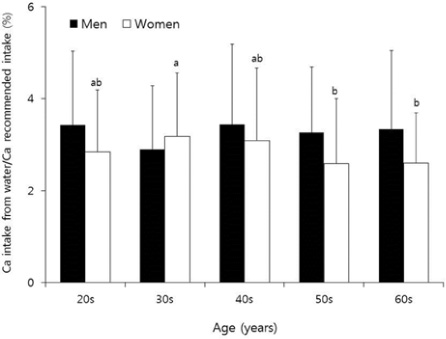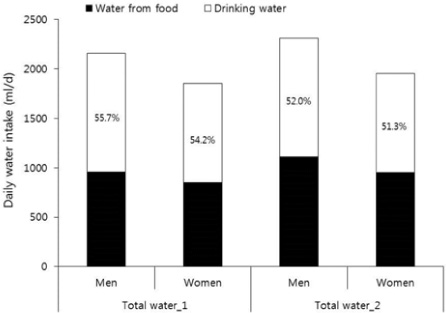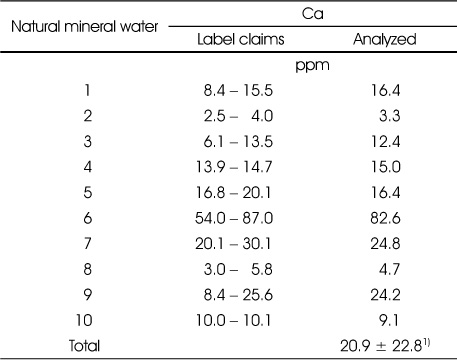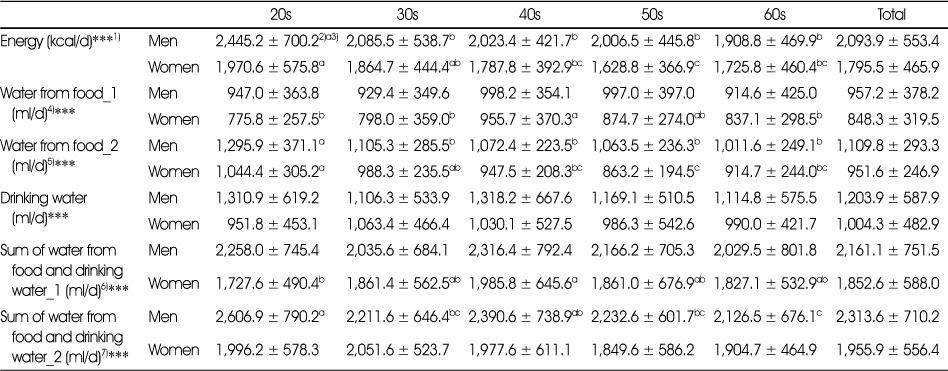Articles
- Page Path
- HOME > Korean J Community Nutr > Volume 24(1); 2019 > Article
-
Research Article
- Daily Water Consumption and its Contribution to Calcium Intake in Korean Adults
-
Eun-Sun Park, Yeon-Kyung Lee, Mi-Hyun Kim, Mi-Kyeong Choi

-
Korean Journal of Community Nutrition 2019;24(1):18-23.
DOI: https://doi.org/10.5720/kjcn.2019.24.1.18
Published online: February 28, 2019
1Division of Food Science, Kongju National University, Yesan, Korea, Student.
2Department of Food Science and Nutrition, Kyungpook National University, Daegu, Korea, Professor.
3Division of Food Science, Kongju National University, Yesan, Korea, Professor.
- Corresponding author: Mi-Kyeong Choi. Division of Food Science, Kongju National University, Yesan 32439, South Korea. Tel: (041) 330-1462, Fax: (041) 330-1469, mkchoi67@kongju.ac.kr
Copyright © 2019 The Korean Society of Community Nutrition
This is an Open-Access article distributed under the terms of the Creative Commons Attribution Non-Commercial License (http://creativecommons.org/licenses/by-nc/3.0/) which permits unrestricted non-commercial use, distribution, and reproduction in any medium, provided the original work is properly cited.
- 1,561 Views
- 4 Download
- 2 Crossref
Figure & Data
REFERENCES
Citations

- Assessing contribution of bottled water in nutrient absorption using the bottled water nutritional quality index (BWNQI) in Iran
Masoomeh Askari, Reza Saeedi, Ramin Nabizadeh, Ahmad Zarei, Maryam Ghani, Marzieh Ehsani, Mahmood Alimohammadi, Mehrnoosh Abtahi
Scientific Reports.2021;[Epub] CrossRef - Variability of urinary creatinine, specific gravity, and osmolality over the course of pregnancy: Implications in exposure assessment among pregnant women
Gowoon Lee, Sunmi Kim, Hyunwoong Park, Jeonghwan Lee, Jung Pyo Lee, Younglim Kho, Gyuyeon Choi, Jiwon Park, Suwalee Worakhunpiset, Hyo-Bang Moon, Kyungho Choi
Environmental Research.2021; 198: 110473. CrossRef


Fig. 1
Fig. 2
Calcium contents in 10 kinds of natural mineral water currently sold in Korea
1) Mean ± SD.
Daily water intake of the subjects
1) Significant difference between men and women by unpaired t-test. ***: p<0.001.
2) Mean ± SD.
3) Different letters in a row indicate significantly difference among age groups at p<0.05 by Duncan's multiple-range test.
4) Water from food_1 = water intake from food calculated using food composition table.
5) Water from food_2 = water intake from food calculated using energy intake (energy intake × 0.53).
6) Sum of water from food and drinking water_1 = water intake from food + drinking water intake.
7) Sum of water from food and drinking water_2 = (energy intake × 0.53) + drinking water intake.
Subjects of 64 men and 64 women for each age group.
Daily calcium intake from food and drinking water of the subjects
1) Mean ± SD.
2) Different letters in a row indicate significantly difference among age groups at p<0.05 by Duncan's multiple-range test.
3) Significant difference between men and women by unpaired t-test. ***: p<0.001.
Subjects of 64 men and 64 women for each age group.
1) Mean ± SD.
1) Significant difference between men and women by unpaired t-test. ***: 2) Mean ± SD. 3) Different letters in a row indicate significantly difference among age groups at 4) Water from food_1 = water intake from food calculated using food composition table. 5) Water from food_2 = water intake from food calculated using energy intake (energy intake × 0.53). 6) Sum of water from food and drinking water_1 = water intake from food + drinking water intake. 7) Sum of water from food and drinking water_2 = (energy intake × 0.53) + drinking water intake. Subjects of 64 men and 64 women for each age group.
1) Mean ± SD. 2) Different letters in a row indicate significantly difference among age groups at 3) Significant difference between men and women by unpaired t-test. ***: Subjects of 64 men and 64 women for each age group.

 KSCN
KSCN





 PubReader
PubReader Cite
Cite


